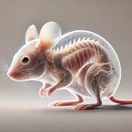The ability to break down plastic has so far been identified in at least 430 species of fungi and bacteria, according to researchers at the Royal Botanic Gardens in Kew, London.
Photo: TASR/Lukáš Grinaj
Mealworms (illustrative photo)
A beetle larva native to Kenya can digest polystyrene. Insects could thus help break down part of the plastic waste that accumulates in landfills and in nature. TASR informs on the basis of Scientific Reports, PLOS One and the Live Science server.
Scientists from the International Center of Physiology and Ecology of Insects (ICIPE) in the Kenyan capital Nairobi have discovered an unexpected ally in the fight against plastic waste. It is the larva of a beetle from the genus Alphitobius, which belongs to the family Tenebrionidae (Moochidae). Larvae can consume up to 50 percent of the polystyrene fed, and this amount can be further increased by mixing the plastic with bran and grain chaff. It is not immediately clear whether these are the larvae of an already known species of insect or a new species, according to the study published on September 12 in the scientific journal Scientific Reports.

Bacteria of the genera Kluyvera, Lactococcus and Klebsiella play a key role in the decomposition of polystyrene. They produce enzymes capable of breaking down the complex polymer bonds of this plastic into simpler compounds, which are then further broken down by the digestive juices in the stomach of mealworms.
Scientists have also noted the ability to break down plastics in some types of wood-destroying fungi. A study published in July 2023 in the scientific journal PLOS ONE revealed that wood-decaying fungi that cause white mold can break down low-density polyethylene (LDPE).
The ability to break down plastic has so far been identified in at least 430 species of fungi and bacteria, according to researchers at the Royal Botanic Gardens in Kew, London. Only a tenth of the approximately 400 million tons of plastic waste produced annually in the world is recycled, and the rest ends up in landfills or in the ocean. The successful identification and replication of enzymes to break down plastics could significantly reduce the amount of plastic waste produced, writes Live Science.

The authors of the study plan to investigate the mealworms further in an effort to uncover specific strains of bacteria and enzymes that break down polystyrene. The results of her study can also help start a process that will enable the transformation of plastic waste into high-value insect protein that can be used as feed in animal production.
The Tenebrionidae family includes more than 20,000 species of small to medium-sized beetles. The larvae of some species are collectively called mealworms and are used as food for birds, reptiles or spiders. Commission Implementing Regulation (EU) 2023/58 of January 5, 2023 approved the larvae of the species Alphitobius diaperinus (the barn owl), which belongs to this family, as a new food in the EU.
(“Novel food is any food that was not used for human consumption to a significant extent in the EU before 5/15/1997,” explains the website of the Public Health Office of the Slovak Republic.)
Source: vat.pravda.sk


